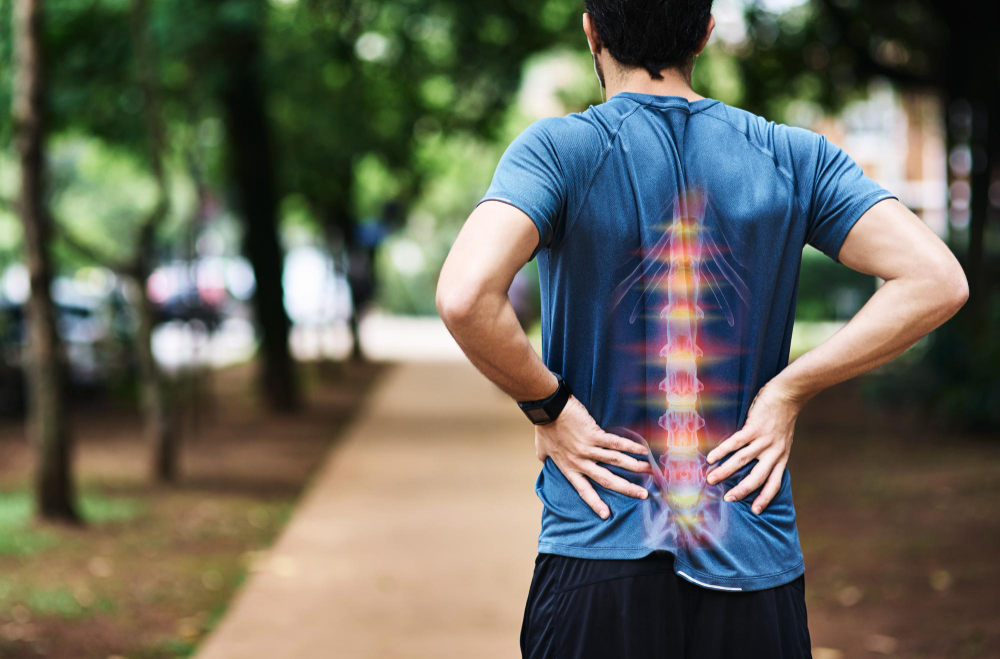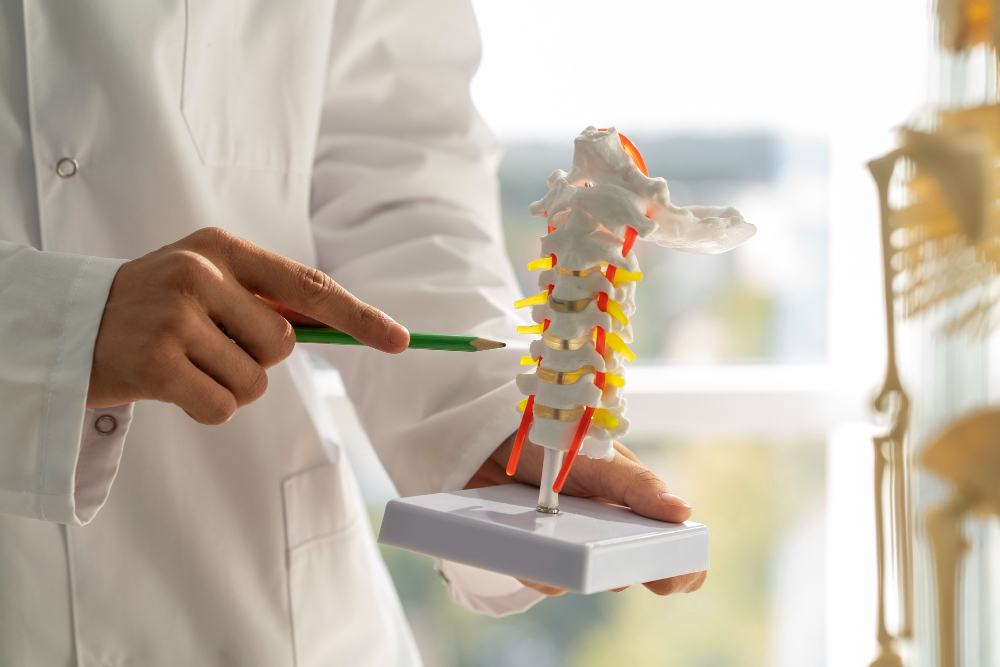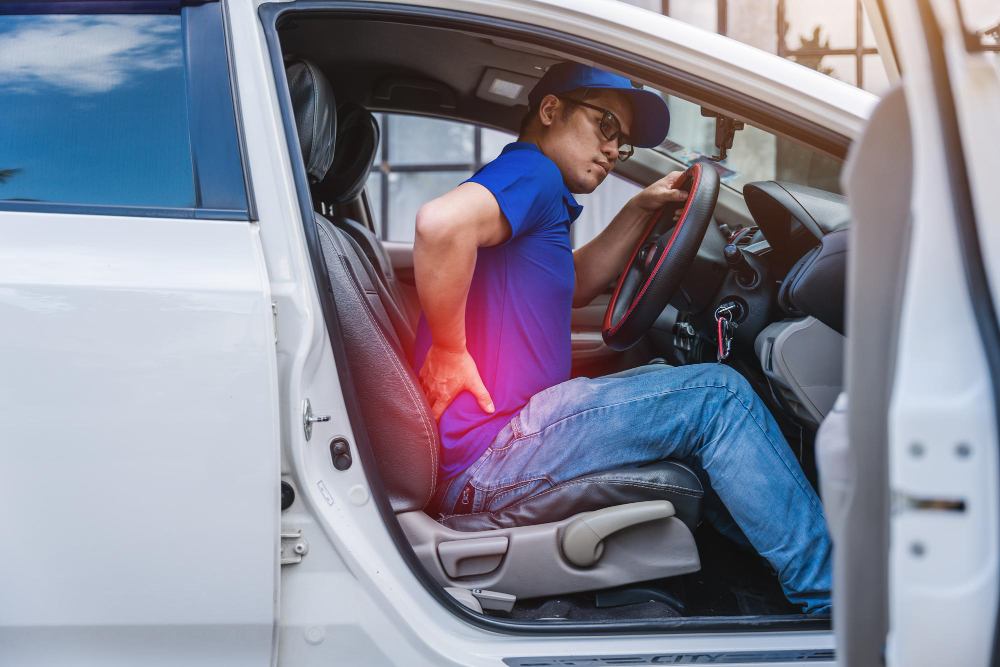Car accidents are a leading cause of back injuries, which can range from mild muscle strains to severe spinal cord damage. The sudden impact and force involved in collisions can lead to various types of back injuries, each with its own set of symptoms and treatment requirements. Understanding these injuries is crucial for recognizing their signs, seeking appropriate medical care, and ensuring a comprehensive recovery. This delves into the most common back injuries resulting from car accidents, exploring their causes, symptoms, and potential treatment options to help individuals navigate their recovery journey.
What Is Back Injury?
A back injury refers to any damage or harm caused to the structures of the back, including the spine, muscles, ligaments, nerves, and other tissues. Back injuries can result from various causes such as trauma, repetitive strain, poor posture, or underlying medical conditions. They can range from mild to severe and may impact a person’s mobility, comfort, and overall quality of life.
Key Components of the Back
Understanding back injuries requires a basic knowledge of the back’s anatomy:
1. Spine (Vertebral Column): The spine is composed of vertebrae (individual bones) stacked on top of each other, separated by intervertebral discs. It provides structural support and houses the spinal cord.
2. Spinal Cord and Nerves: The spinal cord runs through the center of the spine and carries nerve signals between the brain and the rest of the body.
3. Muscles: Numerous muscles in the back provide support, movement, and stability.
4. Ligaments and Tendons: Ligaments connect bones to other bones, while tendons attach muscles to bones, aiding in movement and stability.
Causes Of Back Injuries

Back injuries can result from a variety of incidents and conditions. Understanding these causes is essential for prevention, early detection, and effective treatment.
Here are some common causes of back injuries:
1. Car Accidents
Car accidents are a leading cause of back injuries. The force and sudden impact involved can lead to various types of injuries, such as whiplash, herniated discs, and spinal fractures. Rear-end collisions, side impacts, and head-on collisions can all result in significant trauma to the back.
2. Falls
Falls, from a height or slipping on a surface, can cause serious back injuries. Older adults are particularly at risk due to decreased bone density and balance issues. Common injuries from falls include fractures, sprains, and disc injuries.
3. Heavy Lifting
Improper lifting techniques or lifting heavy objects can strain the muscles, ligaments, and discs in the back. This is a common cause of workplace injuries, especially in occupations requiring manual labor.
4. Sports Injuries
Contact sports like football, rugby, and wrestling, as well as activities like gymnastics and weightlifting, can lead to back injuries. Overuse, improper technique, and sudden impacts are typical contributing factors.
5. Repetitive Movements
Jobs or activities that require repetitive motions, such as bending, twisting, or lifting, can lead to overuse injuries. These repetitive movements can strain the muscles and ligaments, causing chronic pain and discomfort.
6. Poor Posture
Maintaining poor posture for extended periods, whether sitting, standing, or sleeping, can put undue stress on the back. This can lead to muscle fatigue, joint strain, and disc problems over time.
7. Degenerative Conditions
Conditions such as osteoarthritis, degenerative disc disease, and spinal stenosis can weaken the structures of the spine, making it more susceptible to injury. These conditions are often related to aging but can also result from previous injuries.
8. Sudden Movements
Sudden, awkward movements can cause back injuries, such as twisting or bending improperly. These movements can lead to muscle strains, ligament sprains, and disc injuries.
9. Obesity
Excess body weight places additional stress on the spine and back muscles, increasing the risk of injury. Obesity can contribute to the development of conditions like herniated discs and osteoarthritis.
10. Genetics
Some people are genetically predisposed to certain back conditions, such as scoliosis or spondylolisthesis. These hereditary factors can increase the likelihood of developing back injuries or conditions.
What Are The Symptoms Of A Back Injury After A Car Accident?
Experiencing a back injury after a car accident can manifest in a variety of symptoms, which can vary in severity and duration. Recognizing these symptoms early is crucial for prompt medical intervention and effective treatment.
Pain
Pain is the most common and immediate symptom of a back injury following a car accident. This pain can be localized to the lower, middle, or upper back, depending on the injury’s location. It may be sharp and sudden or dull and chronic. In some cases, pain can radiate to other parts of the body, such as the arms or legs, indicating potential nerve involvement, like in the case of a herniated disc or sciatica.
Stiffness And Reduced Mobility
Injuries to the back often result in stiffness and a noticeable reduction in the range of motion. This stiffness can make it difficult to bend, twist, or perform everyday activities. The muscles around the injured area may feel tight and resistant to movement, which can significantly impact one’s ability to perform routine tasks or engage in physical activity.
Numbness And Tingling
Numbness and tingling sensations, often described as “pins and needles,” can occur when there is nerve compression or damage in the back. These sensations may be felt in the back itself or radiate down the limbs, particularly if the injury involves the spinal cord or nerves branching from it. This is a common symptom in cases of herniated discs or spinal stenosis.
Muscle Spasms
Muscle spasms are involuntary contractions of the muscles in the back that can cause significant discomfort and pain. These spasms can be sudden and severe, often occurring shortly after the accident or in the days following. They can make it challenging to maintain certain positions or perform movements without experiencing sharp pain.
Weakness
Back injuries can lead to muscle weakness, particularly in the areas surrounding the injury. This weakness can affect the ability to stand, walk, or lift objects and may cause a noticeable decrease in physical strength and endurance. In severe cases, weakness may extend to the limbs if nerve damage is involved.
Changes In Bladder or Bowel Control
Severe back injuries, especially those affecting the spinal cord, can impact bladder and bowel control. This symptom is a medical emergency and requires immediate attention. Loss of control in these areas can indicate significant nerve damage and requires prompt intervention to prevent permanent damage.
Headaches And Dizziness
While more commonly associated with neck injuries like whiplash, headaches, and dizziness can also accompany back injuries. These symptoms often result from muscle tension, nerve irritation, or as a response to pain and discomfort in the back.
Types Of Back Injuries From Car Accidents
Back injuries are a common and serious consequence of car accidents. These injuries can vary widely in severity and type, affecting different parts of the back and spine. Understanding the types of back injuries that can result from car accidents is crucial for timely diagnosis, treatment, and recovery.
Below are some of the most common types of back injuries sustained in car accidents:
1. Herniated Discs
A herniated disc occurs when the soft, gel-like center of a spinal disc pushes through a crack in the tougher exterior casing. This can irritate nearby nerves and result in pain, numbness, or weakness in an arm or leg.
Symptoms:
- Pain in the lower back or neck
- Radiating pain down the legs or arms
- Numbness or tingling
- Muscle weakness
Causes in Car Accidents: Sudden impact or jarring movements can cause the discs in the spine to shift or rupture.
2. Spinal Fractures
Spinal fractures, or vertebral fractures, occur when one or more of the bones in the spine break. These can range from minor fractures to severe, life-threatening injuries.
Symptoms:
- Severe back pain
- Numbness, tingling, or weakness
- Loss of bladder or bowel control (in severe cases)
- Limited mobility
Causes of Car Accidents: High-impact collisions can compress or crush the vertebrae, leading to fractures.
3. Sprains and Strains
Sprains and strains involve damage to the ligaments, muscles, or tendons in the back. Sprains affect the ligaments (the bands of tissue that connect bones), while strains involve muscles or tendons.
Symptoms:
- Pain and stiffness in the back
- Swelling and bruising
- Muscle spasms
- Limited range of motion
Causes in Car Accidents: Sudden movements or impact can overstretch or tear the ligaments, muscles, or tendons.
4. Spinal Cord Injuries
Spinal cord injuries involve damage to the spinal cord, which can result in partial or complete loss of motor control and sensation below the site of the injury. These are among the most serious types of back injuries.
Symptoms:
- Loss of movement or sensation
- Difficulty breathing (if the injury is high in the spinal cord)
- Loss of bladder or bowel control
- Pain or an intense stinging sensation
Causes in Car Accidents: Severe trauma, such as that from high-speed collisions or rollovers, can damage the spinal cord.
5. Whiplash
Whiplash is a neck injury caused by a rapid back-and-forth neck movement, similar to a whip’s cracking. While it primarily affects the neck, it can also cause upper back pain.
Symptoms:
- Neck and upper back pain
- Stiffness and reduced range of motion
- Headaches
- Dizziness
- Fatigue
Causes in Car Accidents: Rear-end collisions are a common cause of whiplash.
6. Facet Joint Injuries
The facet joints are small stabilizing joints between and behind adjacent vertebrae. Injury to these joints can cause significant pain and mobility issues.
Symptoms:
- A localized pain in the back
- Pain radiating to other areas, such as the buttocks or thighs
- Stiffness and difficulty in movement
Causes of Car Accidents: Sudden impact or twisting motions can damage these joints.
7. Compression Fractures
Compression fractures occur when the vertebrae collapse, which can lead to a reduction in height and severe back pain.
Symptoms:
- Sudden, severe back pain
- Decreased mobility
- Height loss
- Deformity of the spine (kyphosis)
Causes of Car Accidents: High-impact forces can compress the vertebrae, leading to fractures.
Treatment For Back Pain After An Accident

Treating back pain after a car accident involves a combination of immediate and long-term strategies to alleviate pain, promote healing, and restore function. The specific treatment plan will depend on the severity and type of injury, as well as the individual’s overall health and response to treatment.
Initial Medical Assessment
The first step in treating back pain after an accident is a thorough medical assessment. This may include a physical examination, imaging tests (such as X-rays, MRIs, or CT scans), and possibly nerve conduction studies. An accurate diagnosis is crucial for determining the most appropriate treatment plan.
Pain Management
Medications
Over-the-Counter Pain Relievers: Nonsteroidal anti-inflammatory drugs (NSAIDs) like ibuprofen or acetaminophen can help reduce pain and inflammation.
Prescription Medications: For more severe pain, a doctor may prescribe stronger pain relievers, muscle relaxants, or anti-inflammatory drugs.
Ice and Heat Therapy
- Ice Packs: Applying ice packs to the affected area can help reduce inflammation and numb acute pain.
- Heat Therapy: After the initial inflammation has subsided, applying heat can relax muscles and improve blood flow to the injured area.
Physical Therapy
Physical therapy plays a crucial role in the rehabilitation process. A physical therapist will design a personalized exercise program to:
- Strengthen the muscles supporting the spine
- Improve flexibility and range of motion
- Promote proper posture and body mechanics
- Physical therapy may also include manual therapy, massage, and other techniques to alleviate pain and facilitate recovery.
Chiropractic Care
Chiropractic care can be beneficial for certain types of back injuries. Chiropractors use spinal manipulation and other techniques to improve spinal alignment, reduce pain, and enhance mobility. Chiropractic adjustments can be particularly effective for treating whiplash and other musculoskeletal injuries.
Injections
For persistent or severe pain, injections may be recommended. These can include:
- Corticosteroid Injections: To reduce inflammation and pain in the affected area.
- Nerve Blocks: To temporarily disrupt pain signals from specific nerves.
- Epidural Injections: To provide relief from severe pain caused by conditions like herniated discs or spinal stenosis.
Surgical Intervention
Surgery is typically considered a last resort when conservative treatments have failed to provide relief, or when there is significant structural damage, such as:
- Herniated Discs: Surgical removal of the damaged portion of the disc (discectomy).
- Spinal Fractures: Surgical stabilization of the spine using hardware like rods and screws.
- Spinal Cord Compression: Decompression surgery to relieve pressure on the spinal cord or nerves.
Alternative Therapies
Some individuals find relief through alternative therapies such as:
- Acupuncture: Inserting thin needles into specific points on the body to alleviate pain.
- Massage Therapy: Relieving muscle tension and promoting relaxation.
- Yoga and Pilates: Gentle exercises to improve flexibility, strength, and posture.
Lifestyle Modifications
Incorporating lifestyle changes can support the healing process and prevent further injury:
- Ergonomics: Adjusting workspaces and home environments to promote proper posture.
- Exercise: Engaging in low-impact activities like walking, swimming, or cycling to maintain overall fitness and support back health.
- Weight Management: Maintaining a healthy weight to reduce strain on the back.
What Happens If A Back Injury Goes Untreated?
If a back injury goes untreated, it can lead to a range of serious and potentially debilitating consequences. Initially, the pain and discomfort may worsen, making everyday activities increasingly difficult. Untreated back injuries can result in chronic pain, which can severely impact the quality of life and mental health, leading to conditions such as depression and anxiety. Structural damage, such as herniated discs or spinal fractures, can exacerbate over time, potentially causing permanent nerve damage.
This could result in numbness, weakness, or even paralysis in severe cases. Untreated injuries may also lead to compensatory problems, where other parts of the body are strained or injured due to altered movement patterns and poor posture. Overall, the lack of proper medical intervention and treatment can significantly impair an individual’s mobility, independence, and overall well-being.
How Does An Accidental Lawyer Help In Getting A Settlement For Back Injuries From Car Accidents?

Expert Legal Guidance: An accident lawyer provides expert legal advice and guidance throughout the claims process. They understand the complexities of personal injury law and can navigate the legal system effectively.
Gathering Evidence: A lawyer will collect and organize crucial evidence to support your claim, including medical records, accident reports, witness statements, and expert testimonies. This comprehensive evidence is vital for proving the extent and impact of your back injury.
Negotiating with Insurance Companies: Insurance companies often aim to minimize payouts. An experienced lawyer can negotiate on your behalf, ensuring that you receive a fair settlement that covers medical expenses, lost wages, pain and suffering, and other related costs.
Maximizing Compensation: Lawyers can accurately assess the value of your claim by considering current and future medical expenses, rehabilitation costs, and the impact on your quality of life. They strive to maximize the compensation you receive.
Legal Representation in Court: If a fair settlement cannot be reached through negotiation, an accident lawyer will represent you in court, advocating for your rights and presenting a compelling case to ensure you receive the compensation you deserve.
FAQs
What are the most common types of back injuries caused by car accidents?
The most common types of back injuries from car accidents include herniated discs, spinal fractures, muscle strains, ligament sprains, and whiplash. Each type of injury varies in severity and requires different treatment approaches.
How can I tell if my back pain after a car accident is serious?
If you experience severe pain, numbness, tingling, weakness, or loss of bladder or bowel control, it is important to seek immediate medical attention. Persistent pain or stiffness that doesn’t improve with rest and over-the-counter pain relief also warrants a visit to a healthcare professional.
What is a herniated disc, and how does it occur in a car accident?
A herniated disc occurs when the soft, gel-like center of a spinal disc pushes through a tear in the tougher outer layer. This can happen during a car accident due to the sudden impact and force, causing severe pain and possibly nerve damage.
Can whiplash from a car accident cause back pain?
Yes, whiplash primarily affects the neck but can also cause upper back pain. It occurs when the head and neck are suddenly jerked forward and backward, straining the muscles and ligaments in the neck and upper back.
What should I do if I suspect a back injury after a car accident?
If you suspect a back injury after a car accident, seek medical attention immediately. A healthcare professional can conduct a thorough examination, possibly including imaging tests, to diagnose the injury and recommend appropriate treatment to prevent further complications.
Seeking For Settlement Help Contact Us
If you or a loved one has suffered a back injury from a car accident, our experienced accidental injury lawyers are here to help. We understand the physical, emotional, and financial toll that such injuries can take, and we are committed to securing the compensation you deserve. Contact us today for a free consultation to discuss your case and learn how we can assist you in navigating the legal process. Our dedicated team will provide personalized attention and expert guidance every step of the way.
Interesting Reads:






